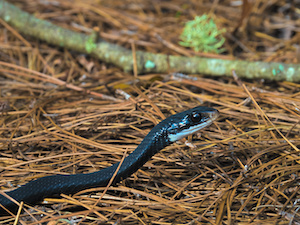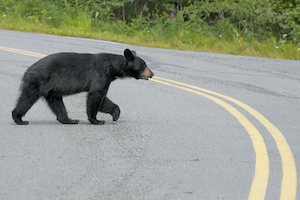As Georgia’s suburban and urban environments continue to grow, more humans and wildlife are interacting. These interactions can be positive, like enjoying birds at your birdfeeder, or negative, like a bear or squirrel eating your birdseed. Negative interactions can cause conflicts between humans and wildlife. Most of these conflicts can be easily resolved or prevented by taking a few simple steps to eliminate attractants and haze unwanted wildlife from your yard or property.
What is an Attractant?
Wildlife are constantly searching for food, water, and shelter. These essential needs are attractants and your yard may be providing them, either intentionally or unintentionally.
- Common food attractants: trash, pet food, bird seed
- Can attract raccoons, coyotes, foxes, bears, and rodents
- Common water attractants: pet water bowls, ponds, pools
- Can attract raccoons, coyotes, foxes, bears, and waterfowl
- Common shelter attractants: downed brush, leaf litter, pine straw
- Can attract rodents and snakes
If the attractant cannot be easily removed, you may be able to use an exclusion method to make it inaccessible to wildlife.
For example, deer grazing on landscaping. Place netting or fencing around the landscaping area to prevent grazing.
Once you’ve identified and removed or excluded the attractant(s) from your yard or property, give wildlife time to figure out that food, water, or shelter source is no longer available, typically one to two weeks. For help with a specific wildlife species, see our Living with Wildlife pages below.
What is Hazing?
Wildlife is naturally wary of people. Continued exposure to people can decrease this natural fear over time. Hazing (or scaring) uses deterrents or negative stimuli to move wildlife out of an area and is an important part of keeping wildlife wild.
- Examples of deterrents: motion activated sprinklers or alarms, electric fencing
- Examples of negative stimuli: yelling, noisemakers, spraying animal with a water hose
Hazing efforts will be less effective on wildlife if attractants are not removed or excluded. It is also beneficial to vary your hazing techniques so wildlife does not become desensitized to one hazing method.
Safety Tips for Pet Owners
Most wildlife are not interested in humans or pets. However, there are times when wildlife and pets have negative encounters. Large dogs can be viewed as a threat to wildlife with young. Small dogs and cats can be viewed as potential food sources. Securing attractants that bring wildlife into your yard can minimize the risk for your and your pet. Here are some other helpful tips to minimize negative interactions:
- Keep pets inside or leashed when outside.
- Monitor pets when they are outdoors, even in a fenced in yard.
- Be alert when walking at dawn or dusk with pets.
- Carry an air horn or noise maker when walking pets.
Common Conflict Species
For information on common conflict species:
- Alligators
- Bats
- Bears (Fact Sheet & BearWise)
- Beavers
- Canada Geese
- Coyotes
- Deer
- Feral Hogs
- Foxes
- Raccoons
- Squirrels
- Woodpeckers
- Vultures
Need wildlife trapped and removed from your property?
You can hire a nuisance wildlife control operator, remove the animal yourself during regulated hunting and trapping seasons, or obtain a nuisance wildlife control permit from the Georgia Department of Natural Resources. Always consult your local ordinances regarding rules related to discharging firearms.
- Visit https://gadnrle.org/special-permits#nuisance for a list of nuisance wildlife trappers, a nuisance control application and renewal, and more
- Wildlife Control Permit Information
- Georgia Hunting Seasons and Regulations
